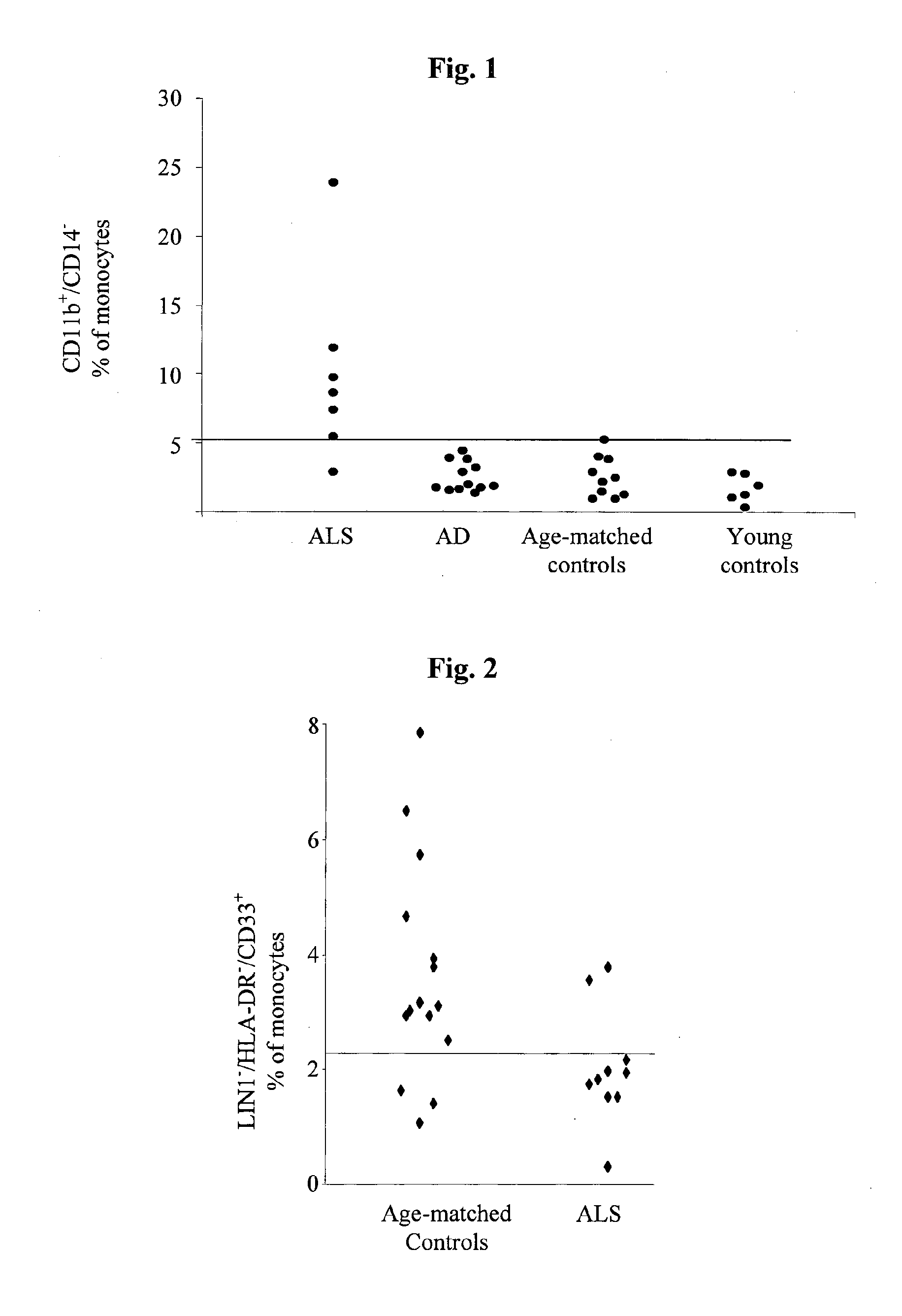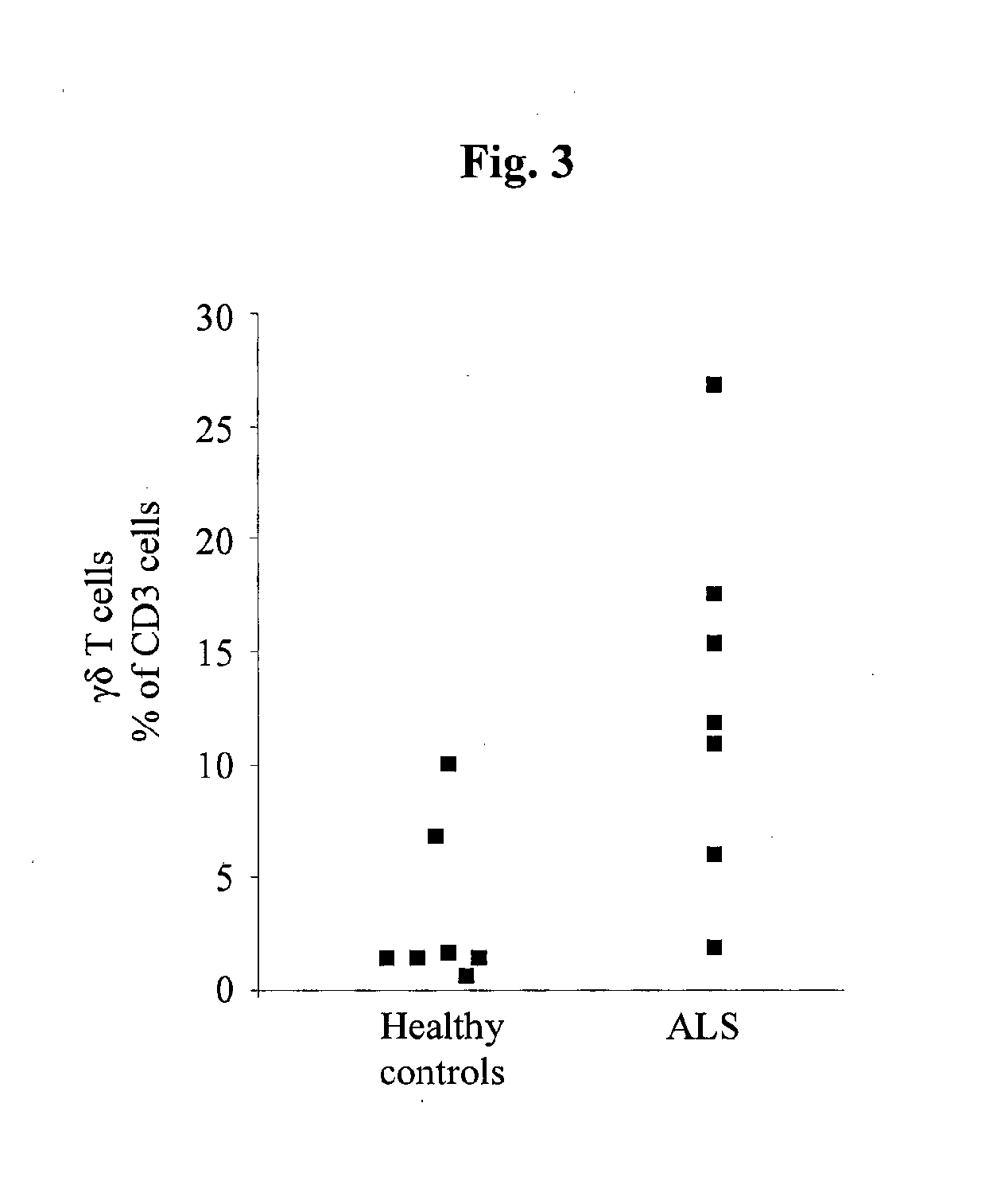Cellular blood markers for early diagnosis of als and for als progression
a technology of als and blood markers, applied in the direction of metabolism disorders, instruments, peptide/protein ingredients, etc., can solve the problems of long time-consuming and laborious, difficult to correctly diagnose patients, and inability to detect etc., to achieve the effect of reducing the level of myeloid derived suppressor cells
- Summary
- Abstract
- Description
- Claims
- Application Information
AI Technical Summary
Benefits of technology
Problems solved by technology
Method used
Image
Examples
example 1
ALS Patients Show Elevated Level of CD11b+ / CD14− Cells in PBMCs Compared with Alzheimer's Patients and Healthy Controls
[0107]Myeloid suppressor cells constitute a population of immature myeloid cells with potent immunosuppressive functions. These cells have been shown to infiltrate tumors and to regulate adaptive immune responses to cancer cells in experimental animals and human cancer patients. They can induce immunosuppression under normal, inflammatory or surgical / traumatic stress conditions. The accumulation of myeloid suppressor cells is one of the major mechanisms of tumor escape (Frey, 2006; Serafini et al., 2006a; Bunt et al., 2006; Makarenkova et al., 2006). Myeloid suppressor cells are of interest because they have the ability to suppress T-cell immune responses by a variety of mechanisms (Sica and Bronte, 2007; Serafini et al., 2006a; Talmadge, 2007; Nagaraj and Gabrilovich, 2007). These cells are heterogeneous cellular population containing macrophages, granulocytes, imm...
example 2
ALS Patients Show Elevated Level of Lin− / DR− / CD33+ Cells in PBMCs Compared with Healthy Controls
[0109]Since the myeloid cell population contains many different cell types and myeloid cell differentiation is a continuum of processes, MDSCs may display diverse phenotypic markers that reflect the spectrum of immature to mature myeloid cells.
[0110]In this study we show that the level of Lin− / DR− / CD33+ cells, i.e., a phenotype of MDSC different than that shown in Example 1, in the blood of ALS patients is elevated as well. In particular, whole blood sample of ALS patients and healthy controls (n=15 and 10, respectively) were stained with monoclonal antibodies against Lin, HLA-DR and CD33; and the percentage of Lin− / HLA-DR− / CD33+ cells out of total monocyte population for each patient was determined by FACS. As shown in FIG. 2, the percentage of Lin− / HLA-DR− / CD33+ myeloid cells out of total monocytes in
[0111]ALS patients was significantly higher compared to healthy controls.
[0112]It was f...
example 3
ALS Patients Show Elevated Level of Gamma-Delta T-Cells
[0113]Gamma-delta (γδ) T cells represent a small subset of T cells possessing a distinct T cell receptor (TCR) on their surface. These cells are implicated in host defense against microbes and tumors but their mode of function remains largely unresolved.
[0114]A variety of sometimes-conflicting effector functions have been ascribed to these cells depending on their tissue distribution, antigen-receptor structure and local microenvironment. In particular, they were shown to play a role in immunosurveillance and immunoregulation (Girardi, 2006), and were found to be an important source of IL-17 (Roark et al., 2008) and to induce robust CD8+ cytotoxic T cell response (Brandes et al., 2009).
[0115]In this study, the level of γδ T cells in PBMCs of ALS patients was compared with that in PBMCs of healthy controls. In particular, freshly isolated PBMCs of ALS patients and healthy controls (n=7 in each group) were double-stained with mono...
PUM
| Property | Measurement | Unit |
|---|---|---|
| time | aaaaa | aaaaa |
| time | aaaaa | aaaaa |
| time | aaaaa | aaaaa |
Abstract
Description
Claims
Application Information
 Login to View More
Login to View More - R&D
- Intellectual Property
- Life Sciences
- Materials
- Tech Scout
- Unparalleled Data Quality
- Higher Quality Content
- 60% Fewer Hallucinations
Browse by: Latest US Patents, China's latest patents, Technical Efficacy Thesaurus, Application Domain, Technology Topic, Popular Technical Reports.
© 2025 PatSnap. All rights reserved.Legal|Privacy policy|Modern Slavery Act Transparency Statement|Sitemap|About US| Contact US: help@patsnap.com


